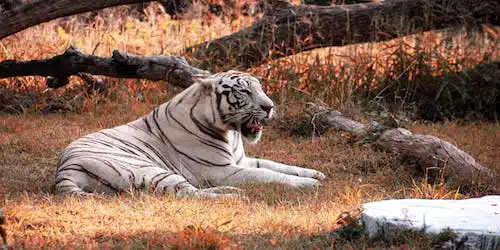When we hear the word “safari,” we picture a group of travelers traveling over the savannah of Africa in pursuit of big wild animals like elephants, buffalo, rhinoceros, and lions. Images from the past typically depict guys wearing pith helmets and brandishing firearms, while images from the present day show individuals driving SUVs and clutching long-lens cameras. It’s a literal quest for animals, or more accurately, a hunt for photos in the immensity of the hottest continent.
Fashion experts might also recall straight-cut, beige-colored garments with a wide belt and a wide-brimmed hat, which were a holdover from the British military’s time spent in Britain’s colonies in Africa. These are all the first things that come to mind when we hear the lovely word “safari,” which has the sound of an Arabic given name.
Today’s safari is a sightseeing trip to a national park in Africa with the primary goal of seeing wildlife. Safaris used to be planned with the intention of hunting big game. The traditional Big Five of Africa—the elephant, lion, rhino, African buffalo, and leopard—are connected to the continent’s hunting customs. Hunters regarded these five animals as the most dangerous and difficult to hunt, and their body parts were the most sought-after trophy.
What Is a Safari?
A safari is an on-land excursion to see wildlife in large, unspoiled areas of the natural world. Safaris are typically conducted in the savannahs and deserts of African nations like Tanzania, Kenya, and Namibia. Africa is where the word “safari” first appeared and has since come to represent the continent.
By protecting natural ecosystems, fostering economic growth, encouraging cross-cultural interaction, increasing environmental consciousness, and offering educational opportunities, safari tourism improves the well-being of the surrounding community. Potential negative aspects of safari include congestion, habitat degradation, animal welfare issues, environmental effects, and poor infrastructure and accessibility. It takes responsible management to reduce these problems and guarantee a great safari experience.
The characteristics of a safari to be aware of are:
#1. Wildlife Observation
A safari’s primary goal is to see and interact with wildlife. Visitors can witness an extensive variety of creatures in their native environments, including zebras, lions, elephants, giraffes, and giraffes. Safaris offer an opportunity to observe animal behavior, discover the habitats of these creatures, and take in the splendor of the natural world.
#2. African Destination
Africa is usually linked with safaris because of the continent’s renowned wildlife and abundant biodiversity. Popular safari locations include Kenya, Tanzania, South Africa, Botswana, and Namibia. Every destination has its own distinct wildlife species, ecosystems, and scenery.
#3. Types of Safaris
Different safari varieties are available to accommodate a range of budgets and preferences. Open-air vehicle game drives, walking safaris, birdwatching safaris, photography safaris, luxury resort safaris, and camping safaris are a few examples. A safari can last anywhere from a few days to several weeks if it’s an extended overland journey across several nations.
#4. Benefits to Local Communities
Local communities can benefit from safari tourism. It can help with conservation efforts, support neighborhood businesses, and create job possibilities. Sustainable safari tourism seeks to maintain a balance between economic development and conservation by benefiting local communities as well as wildlife.
#5. Knowledgeable Guides
Experienced guides with extensive understanding of the region’s species, habitats, and conservation initiatives lead safaris. These guides are essential for giving advice, guaranteeing security, and improving the whole safari experience. They assist in identifying wildlife, explain animal behavior, and provide fascinating environmental information.
#6. Conservation and Sustainability
Many safari operators give sustainability and conservation top priority. They encourage ethical tourist practices, help local people, and support efforts to save animals. The goal of ethical safaris is to boost regional economies while reducing adverse effects on ecosystems and wildlife.
#7. Cultural Interactions
Safaris frequently offer chances for cross-cultural exchanges with nearby populations. Certain safari companies arrange for excursions to nearby communities, providing guests with an opportunity to discover customs, handicrafts, and lifestyles. These exchanges can promote deep connections and provide a better understanding of the local way of life.
#8. Accommodation Options
Safaris provides a variety of lodging choices to accommodate a range of tastes and price points. These can be treehouses, mobile campers, tented campgrounds, or even opulent lodges. The design of accommodations frequently aims to fit in with the surrounding environment, offering a distinctive and immersive experience.
#9. Adventure and Excitement
When visitors explore the environment and get up close and personal with wildlife, safaris provide an exhilarating and adventurous experience. The excitement of being in nature and the unpredictable nature of wildlife sightings combine to produce lifelong memories.
#10. Ethical Considerations
The goal of responsible tourist activities is to reduce adverse effects on local communities and wildlife. Respect for wildlife, conservation, and the uplift of regional economies are the top priorities of ethical safaris. Numerous safari operators support efforts to conserve animals and follow sustainable methods.
Benefits of Safaris
Both tourists and the local community benefit greatly from safaris. The following are some of the main advantages of safari travel:
#1. Preserving Natural Environments
Safaris aid in the preservation of natural ecosystems and habitats. Safari tourism contributes to the preservation of vital wildlife habitats and biodiversity by promoting protected areas and national parks. For species to survive over the long term and for ecosystems to be healthy overall, this is essential.
#2. Development of the Economy
The local economies of African nations benefit greatly from safari tourism. They provide jobs for guides, drivers, lodge employees, and artists in the surrounding towns. Additionally, safari tourism boosts the hotel, transportation, and handicraft industries, resulting in increased economic growth and better living conditions for people.
#3. Preservation of Culture
Safaris frequently offer chances for cross-cultural exchanges with nearby populations. By teaching visitors about traditional crafts, ways of life, and rituals, travel promotes cross-cultural understanding and the preservation of native cultures. This fosters understanding among people and aids in the preservation of cultural heritage.
#4. Concern for the Environment
Safaris serves to increase public understanding of the value of sustainable practices and environmental conservation. Visitors get up close and personal with nature, seeing directly the fragility and beauty of ecosystems. This may result in a greater awareness of environmental issues and a greater motivation to safeguard natural resources.
#5. Research and Education
Safaris provide travelers with educational chances to learn about ecosystems, wildlife, and conservation initiatives. Skilled tour leaders offer valuable perspectives on wildlife challenges, ecology, and animal behavior. Because the money raised from safari tourism may be put toward animal studies and monitoring initiatives, it also promotes scientific study.
#6. Beneficial Effect on the Community
Local communities can benefit from safari tourism. It lessens dependency on unsustainable practices like poaching and habitat degradation by offering a source of income and economic stability. Furthermore, safari operators frequently take part in community development initiatives that promote infrastructure, healthcare, and education.
#7. Recreation and Adventure
Safaris provide tourists with exciting and different experiences. The opportunity to interact closely with different species, explore vast landscapes, and fully immerse oneself in nature provides a sense of adventure and leisure. Safaris foster a strong bond with nature and the creation of enduring memories.
#8. Assistance with Local Wildlife Recovery and Rescue
A few safari operators take an active role in projects to rescue and rehabilitate wildlife. These programs seek to recover hurt or abandoned animals, put them through rehabilitation, and then release them back into the wild. By funding and supporting these programs, safari tourism aids in the preservation and repopulation of animal species.
#9. Encouraging Conscientious Travel
Safari tourists frequently adhere to responsible tourism standards, which include minimizing negative effects on the environment, respecting local customs, and helping local people. Travelers can make sure that their tourism activities have a beneficial social, economic, and environmental impact by selecting ethical safari operators.
#10. Link to Indigenous Wisdom
Interactions with local populations, who have invaluable indigenous knowledge about wildlife, flora, and ecosystems, are a common part of safari excursions. Travelers may benefit from and appreciate this information, which promotes cross-cultural dialogue and preserves traditional ecological understanding.
Cons of Safaris
Safari travel has many advantages, but it’s important to take into account any potential disadvantages and difficulties, such as
#1. The Effect on the Environment
Safari tourism may have an adverse effect on the ecosystem, especially if it is not handled properly. An increase in visitors may result in pollution, wildlife disturbance, and habitat damage. During game drives, off-roading can destroy flora and disturb animal habitats.
#2. Concerns Regarding Animal Welfare
Certain safari experiences may raise ethical questions regarding the well-being of the animals. Animal welfare and treatment can be questioned when participating in activities like petting wildlife, riding elephants, or interacting with confined animals.
#3. Natural Behavior Disruption and Habituation
Wildlife can become accustomed to human presence through repeated exposure, which can change their normal behavior. Changes in eating habits, mating habits, and territorial customs may result from this. In order to reduce the disturbance of wildlife, safari operators and guests need to keep a safe distance and follow the rules.
#4. Overcrowding of tourists
Popular safari locations may get large volumes of visitors, particularly during the busiest times of the year. This may result in crowding, lengthy lines, and a diminished feeling of seclusion and calm.
#5. Limited Infrastructure and Accessibility
Accessibility and infrastructure may be limited at some safari sites, especially in isolated or wilderness areas. This may lead to problems like few options for lodging, rudimentary amenities, and poor connectivity.
#6. Seasonal Differences in the Sightings of Wildlife
Observations of wildlife may differ based on the time of year and the animals’ migration routes. It can be unpredictable to spot a particular species at certain periods of the year because some animals migrate to different regions.
#7. Cost Considerations
Safari travel can be costly, particularly when taking into account the cost of lodging, transportation, park admission, and other extras. Safaris may get very expensive overall, especially if they include luxury lodges and unique experiences.
#8. Scarcity of Water
Water scarcity can be a problem at some safari sites, especially in arid or semi-arid areas. The increased water use of lodges, campgrounds, and tourists may strain the local water supplies, which could lead to a water shortage for the local population and wildlife.
#9. Adverse Socioeconomic Outcomes
Although there may be positive macroeconomic consequences from safari tourism, there may also be negative ones. Local communities may have to deal with issues like unfair tourism revenue distribution, scarce job prospects, or cultural shifts brought about by more visitors.
#10. The Illegal Wildlife Trade
Safari locations could be vulnerable to poaching and the illegal trafficking of endangered animals, among other forms of wildlife trade. Ivory, horns, and skins are examples of wildlife items whose demand can fuel illicit activities that endanger wildlife populations and jeopardize conservation efforts.
Various Safari Locations
Africa is the safari’s native land and unquestionably has the world’s top safari spots.
There are national parks elsewhere, especially in India, Sri Lanka, and Brazil, that provide safari-style experiences and amazing chances to observe wildlife in hotspots. However, nothing compares to Africa in terms of the diversity, abundance, and density of animals, as well as the size of the national parks, some of which are larger than several European nations.
#1. Kenya
Kenya is well known for its stunning landscapes and varied fauna. It provides access to well-known safari locations like Tsavo National Park, Amboseli National Park, and Maasai Mara National Reserve. The safari sector in Kenya is well-established, offering a variety of lodging choices and first-rate facilities.
#2. Africa
With a vast variety of species and varied ecosystems, South Africa is a well-liked safari destination. One of the most well-known safari parks in the nation, Kruger National Park provides fantastic chances to see animals. Madikwe Game Reserve, Addo Elephant National Park, and Hluhluwe-iMfolozi Park are a few other well-known safari locations in South Africa.
#3. Tanzania
The famous Serengeti National Park, well-known for the yearly wildebeest migration, is located in Tanzania. Lake Manyara National Park, Tarangire National Park, and the Ngorongoro Crater are a few more well-liked safari locations in Tanzania. Tanzania offers breathtaking scenery and abundant wildlife.
#4. Botswana
Botswana is renowned for its varied animals and unspoiled nature. For those who enjoy safaris, the Okavango Delta—a distinctive inland delta—is a top attraction. Other noteworthy places in Botswana for a safari experience are the Makgadikgadi Pans, Moremi Game Reserve, and Chobe National Park. High-end and exclusive safari experiences are available in Botswana.
#5. Namibia
Namibia is well known for its striking scenery and distinctive fauna. A well-liked safari location, Etosha National Park is well-known for its plethora of species and salt pan. The Namib Desert, Damaraland, and the Skeleton Coast are among the more noteworthy safari destinations in Namibia. Namibia provides both wildlife experiences and desolate scenery.
#6. Zimbabwe
Zimbabwe has a variety of safari experiences, such as visiting Hwange National Park and the well-known Victoria Falls. Another attraction is Mana Pools National Park, which is well-known for its kayaking and walking safaris. Zimbabwe offers the chance to see the Big Five and take in breathtaking scenery.
#7. Uganda
Uganda is well known for its gorilla trekking adventures in Mgahinga Gorilla National Park and Bwindi Impenetrable National Park. Additionally, it provides chances for wildlife safaris in the national parks of Kidepo Valley, Murchison Falls, and Queen Elizabeth. Uganda offers a special blend of conventional safari experiences and gorilla encounters.
#8. Zambia
Zambia provides exclusive and genuine safari encounters. A well-liked site, South Luangwa National Park is well-known for its walking safaris and profusion of wildlife. Victoria Falls, Kafue National Park, and Lower Zambezi National Park are a few more noteworthy safari destinations in Zambia. There are chances for off-the-beaten-path safari experiences in Zambia.
#9. Rwanda
Although Volcanoes National Park is the most well-known destination for mountain gorilla trekking, Akagera National Park provides opportunities for wildlife safaris. Gorilla encounters and Savannah animal experiences are combined in a way that is exclusive to Rwanda.
#10. Madagascar
Madagascar has a distinctive flora and fauna and is a hotspot for biodiversity. It provides chances for wildlife excursions to see chameleons, lemurs, and other native species. Madagascar’s Ranomafana National Park, Andasibe-Mantadia National Park, and Isalo National Park are notable safari destinations.
Why is it called Safari?
“Safari” is derived from the Swahili word “safari,” which denotes a “journey” or “travel.” Later, it became a term used in English to describe an overland trip to see and interact with wildlife in its native habitat, especially in Southeast Africa. The concept of setting off on a voyage or expedition to discover and take in the many species, landscapes, and civilizations of Africa is encapsulated in the word “safari.” It stands for the excitement, adventure, and discovery that come from seeing wildlife and taking in the natural splendor of Africa.
What is a safari in tourism?
A safari is a term used in tourism to describe an excursion or travel, usually in Africa, for the purpose of seeing and experiencing wildlife in its native settings. It entails visiting game reserves, national parks, and other protected places where tourists can see a variety of animals, including the well-known “Big Five” (tiger, lion, buffalo, leopard, and rhinoceros). In the tourism industry, a safari’s main goal is to offer guests an exceptional and genuine animal experience while supporting sustainable practices and conservation. Responsible tourism is a top priority for many safari operators and resorts, who make sure that local populations gain, wildlife and habitats are preserved, and cultural heritage is honored.
Which animal is called Safari?
The word “safari” describes an excursion or travel to view and interact with wildlife in their natural environments, not a particular animal. Elephants, lions, giraffes, zebras, rhinoceroses, cheetahs, leopards, buffalos, hippos, and several species of antelope are examples of safari animals. In the grasslands and savannas of Africa, safari excursions frequently bring visitors into contact with these creatures.
Summary
A safari excursion consists of three components: transfers from the hotel to the national park, rest at one of the neighboring hotels, and safari vehicle drives. With careful planning, you may cut down on transfer time and free up more time for relaxation or enjoyment of the major events.
Generally speaking, it’s a good idea to spend three or even five days in the same park. In this manner, you can take advantage of all a park has to offer, including the noteworthy locations that hurried travelers frequently overlook.
- Best Tanzania Safari Tours And Packages
- THE BEST SAFARI TOURS & PACKAGES IN AFRICA
- BEST KENYA SAFARI TOURS AND PACKAGES
- BEST SAFARI IN AFRICA
- AFRICAN SAFARI PACKAGES: Unveiling the Wonders of Untamed Wildlife and Scenic Beauty






